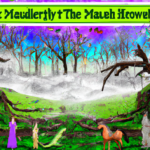
Introduction
As a reader of high fantasy, I’ve always been fascinated by the ways in which authors create their own worlds and magical systems. However, one thing that often catches my attention is the lack of strong female characters and their stereotypical representations in various works of high fantasy. While there have been some improvements in recent years, it’s still a significant issue that needs to be addressed. In this article, we’ll explore the topic of female heroes in high fantasy and how their representation can break stereotypes. We’ll delve into the ways in which authors are challenging gender norms and creating realistic and relatable female characters in their works.
Defining High Fantasy
To begin, it’s crucial to examine what defines high fantasy as a genre and why it’s popular. High fantasy is a sub-genre of fantasy fiction that often involves elaborate settings, multi-dimensional characters, and intricate magical systems. These stories are often set in entirely new worlds that are different from our own, and as such, they create a sense of escapism for readers. These immersive elements of high fantasy are what make it such a beloved genre.
Women’s Representation in High Fantasy
When it comes to female representation in high fantasy, there has been a long-standing issue of underrepresentation and stereotyping. For years, women in high fantasy have been relegated to the role of damsels in distress, love interests, or just weaker versions of their male counterparts. This lack of representation is not only unfair but also detrimental to the genre as a whole. Readers need to see themselves reflected in the stories they read, and when half of the population is not adequately represented, it takes away from the overall experience. Additionally, the portrayal of women as weak or subordinate perpetuates harmful gender stereotypes that have no place in modern society. Female representation in high fantasy needs to improve, and it’s up to authors to change this.
Identifying Stereotypes in Female Characters
Identifying stereotypes in female characters is key to challenging them through the construction of more realistic and multidimensional female heroes in high fantasy. Some of the most common stereotypes include the classic damsel in distress, the overly sexualized woman, and the femme fatale. In most cases, these stereotypes are not only extreme but also reductionist in nature, undermining the value and complexity of women’s experiences. The damsel in distress archetype, for instance, portrays women as helpless and in need of male protection. The overly sexualized woman, on the other hand, reduces women to mere objects of male desires. While the femme fatale is often considered as an empowered female character, in many cases, her agency is linked to her sexuality and attractiveness. By highlighting such stereotypes, authors are increasingly creating strong and relatable female heroes who challenge them by illustrating the complexity and diversity of women’s lives, personalities, and experiences.
Challenging Stereotypes through Female Heroes
To challenge gender stereotypes in high fantasy, authors are actively creating female heroes that go against gender norms and illustrate women’s power and agency. These female heroes are often multidimensional, with their strengths and weaknesses making them more relatable and realistic. For instance, heroes like Arya Stark, Hermione Granger, and Eowyn are determined, resolute, and independent. They are also portrayed as loyal friends, daughters, and sisters, which adds more depth to their character and showcases their range. Another common trait of female heroes in high fantasy is their ability to rise above their circumstances and fight for what they believe in. They are often brave, resourceful, and skilled, and they don’t let gender norms dictate their actions. Such portrayals of female heroes in high fantasy challenge gender stereotypes, empower women and girls, and promote messages of strength, resilience, and determination. Therefore, female heroes in high fantasy represent a shift towards a more gender-equal and inclusive genre.
Examples of Female Heroes in High Fantasy
There are many examples of female heroes in high fantasy that effectively break gender stereotypes and create positive representations of women. One such example is Vin, the protagonist in Brandon Sanderson’s Mistborn series. Vin is initially introduced as a thief and a survivor, but over time, she develops into a skilled warrior and leader. Her character is complex and well-rounded, and she defies gender norms by being both physically strong and emotionally vulnerable. Another example is Katniss Everdeen from Suzanne Collins’ The Hunger Games series. Katniss is a reluctant hero who is forced into a deadly game but ultimately becomes a symbol of rebellion against an oppressive regime. She is strong, intelligent, and determined, but she is also flawed and conflicted, which makes her more relatable to readers. These female heroes, among others, are inspiring models of empowerment and representation for women and girls. They show that women can be just as capable, intelligent, and strong as men, and they deserve to be portrayed as such in high fantasy novels.
Conclusion
In conclusion, high fantasy as a genre is evolving toward more progressive and inclusive representation, particularly in the area of female heroes. The portrayal of multidimensional female heroes who defy gender norms and stereotypes is becoming increasingly common, opening new avenues for readers and authors alike. This shift in representation is essential because it enables women to see themselves as capable and powerful, and it promotes the idea that gender roles do not dictate what individuals can and cannot achieve. As such, female heroes in high fantasy serve as empowering models that challenge gender stereotypes, uplift women, and create more inclusive and diverse imaginary worlds. Ultimately, women’s representation in high fantasy is just the beginning of a broader movement towards more gender equality in literature and society as a whole.







